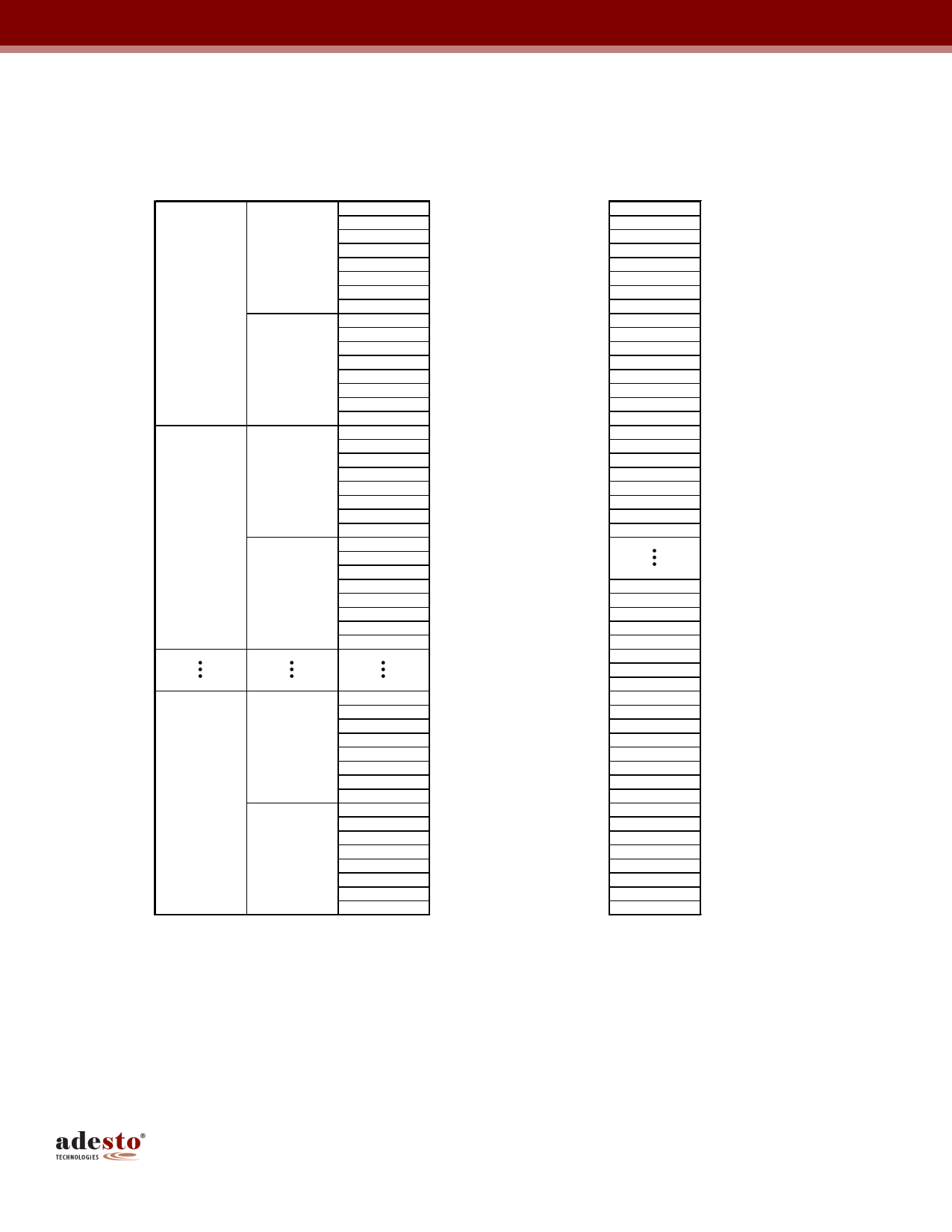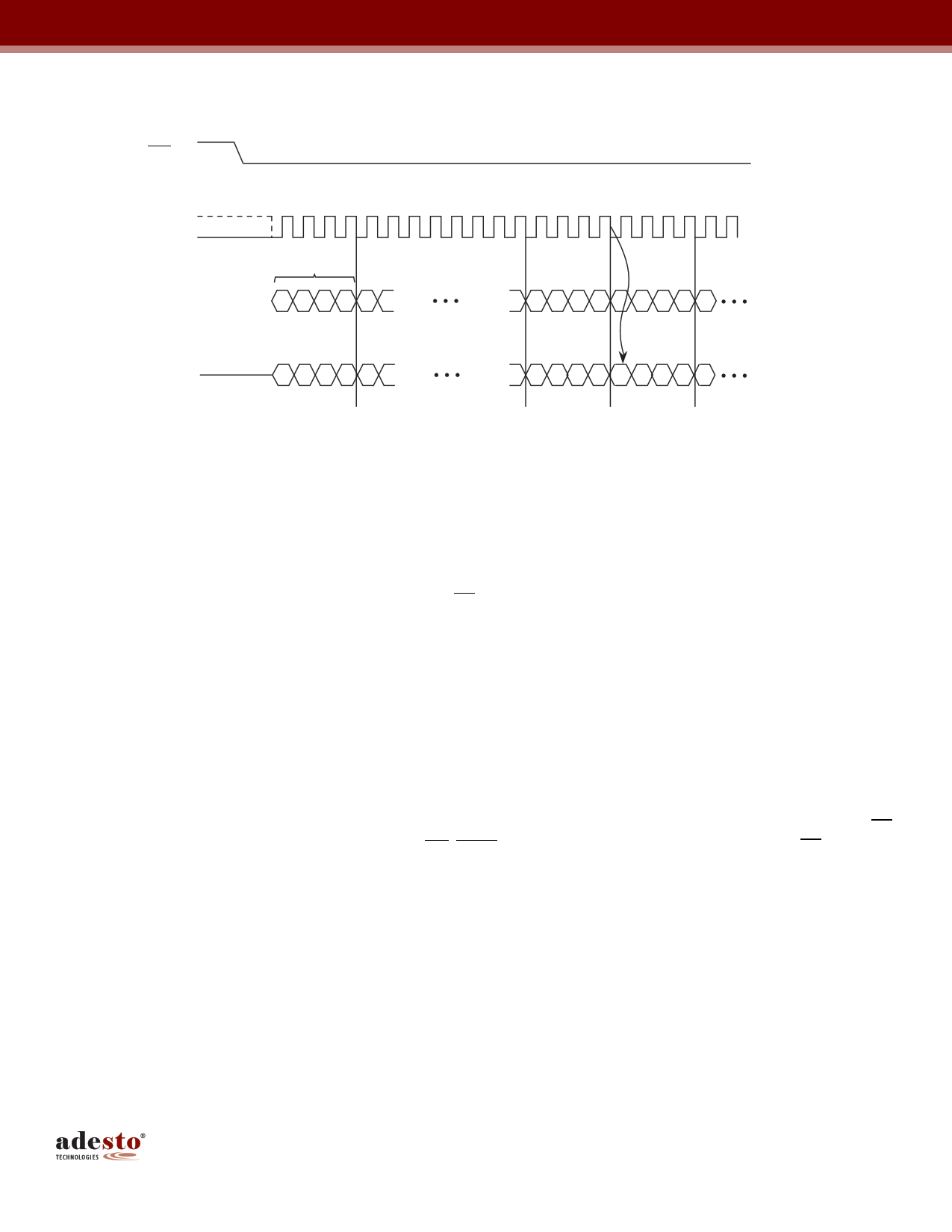
|
|
PDF AT25SF041-MAHD-T Data sheet ( Hoja de datos )
| Número de pieza | AT25SF041-MAHD-T | |
| Descripción | 2.5V Minimum SPI Serial Flash Memory | |
| Fabricantes | Adesto | |
| Logotipo |  |
|
Hay una vista previa y un enlace de descarga de AT25SF041-MAHD-T (archivo pdf) en la parte inferior de esta página. Total 30 Páginas | ||
|
No Preview Available !
AT25SF041
4-Mbit, 2.5V Minimum
SPI Serial Flash Memory with Dual-I/O and Quad-I/O Support
Features
Single 2.5V - 3.6V Supply
Serial Peripheral Interface (SPI) Compatible
Supports SPI Modes 0 and 3
Supports Dual and Quad Output Read
104MHz Maximum Operating Frequency
Clock-to-Output (tV) of 6 ns
Flexible, Optimized Erase Architecture for Code + Data Storage Applications
Uniform 4-Kbyte Block Erase
Uniform 32-Kbyte Block Erase
Uniform 64-Kbyte Block Erase
Full Chip Erase
Hardware Controlled Locking of Protected Blocks via WP Pin
3 Protected Programmable Security Register Pages
Flexible Programming
Byte/Page Program (1 to 256 Bytes)
Fast Program and Erase Times
0.7ms Typical Page Program (256 Bytes) Time
70ms Typical 4-Kbyte Block Erase Time
300ms Typical 32-Kbyte Block Erase Time
600ms Typical 64-Kbyte Block Erase Time
JEDEC Standard Manufacturer and Device ID Read Methodology
Low Power Dissipation
2µA Deep Power-Down Current (Typical)
10µA Standby current (Typical)
4mA Active Read Current (Typical)
Endurance: 100,000 Program/Erase Cycles
Data Retention: 20 Years
Complies with Full Industrial Temperature Range
Industry Standard Green (Pb/Halide-free/RoHS Compliant) Package Options
8-lead SOIC (150-mil and 208-mil)
8-pad Ultra Thin DFN (5 x 6 x 0.6 mm and 2 x 3 x 0.6 mm) (1)
8-lead TSSOP (4 x 4 mm)(1)
1. DFN and TSSOP packages are not currently in production. Package outline dimensions are subject
to change.
DS-25SF041–044C–7/2014
1 page 
Figure 3-1. Memory Architecture Diagram
Block Erase Detail
64KB
32KB
4KB
Block Erase
Block Erase
Block Erase
(D8h Command) (52h Command) (20h Command)
64KB
32KB
32KB
64KB
32KB
32KB
4KB
4KB
4KB
4KB
4KB
4KB
4KB
4KB
4KB
4KB
4KB
4KB
4KB
4KB
4KB
4KB
4KB
4KB
4KB
4KB
4KB
4KB
4KB
4KB
4KB
4KB
4KB
4KB
4KB
4KB
4KB
4KB
Block Address
Range
07FFFFh – 07F000h
07EFFFh – 07E000h
07DF F F h – 07D000h
07CFFFh – 07C000h
07BFFFh – 07B000h
07AF F F h – 07A000h
079FFFh – 079000h
078FFFh – 078000h
077FFFh – 077000h
076FFFh – 076000h
075FFFh – 075000h
074FFFh – 074000h
073FFFh – 073000h
072FFFh – 072000h
071FFFh – 071000h
070FFFh – 070000h
06FFFFh – 06F000h
06EFFFh – 06E000h
06DF F F h – 06D000h
06CFFFh – 06C000h
06BFFFh – 06B000h
06AF F F h – 06A000h
069FFFh – 069000h
068FFFh – 068000h
067FFFh – 067000h
066FFFh – 066000h
065FFFh – 065000h
064FFFh – 064000h
063FFFh – 063000h
062FFFh – 062000h
061FFFh – 061000h
060FFFh – 060000h
64KB
32KB
32KB
4KB 00F F F F h – 00F 000h
4KB 00E F F F h – 00E 000h
4KB 00DF F F h – 00D000h
4KB 00CF F F h – 00C000h
4KB 00BF F F h – 00B000h
4KB 00AF F F h – 00A000h
4KB 009F F F h – 009000h
4KB 008F F F h – 008000h
4KB 007F F F h – 007000h
4KB 006F F F h – 006000h
4KB 005F F F h – 005000h
4KB 004F F F h – 004000h
4KB 003F F F h – 003000h
4KB 002F F F h – 002000h
4KB 001F F F h – 001000h
4KB 000F F F h – 000000h
Page Program Detail
1-256 Byte
Page Program
(02h Command)
256 Bytes
256 Bytes
256 Bytes
256 Bytes
256 Bytes
256 Bytes
256 Bytes
256 Bytes
256 Bytes
256 Bytes
256 Bytes
256 Bytes
256 Bytes
256 Bytes
256 Bytes
256 Bytes
256 Bytes
256 Bytes
256 Bytes
256 Bytes
256 Bytes
256 Bytes
256 Bytes
256 Bytes
Page Address
Range
07FFFFh – 07FF00h
07FEFFh – 07FE00h
07F DF F h – 07F D00h
07FCFFh – 07FC00h
07FBFFh – 07FB00h
07F AF F h – 07F A00h
07F9FFh – 07F900h
07F8FFh – 07F800h
07F7FFh – 07F700h
07F6FFh – 07F600h
07F5FFh – 07F500h
07F4FFh – 07F400h
07F3FFh – 07F300h
07F2FFh – 07F200h
07F1FFh – 07F100h
07F0FFh – 07F000h
07EFFFh – 07EF00h
07EEFFh – 07EE00h
07E DF F h – 07E D00h
07ECFFh – 07EC00h
07EBFFh – 07EB00h
07E AF F h – 07E A00h
07E9FFh – 07E900h
07E8FFh – 07E800h
256 Bytes
256 Bytes
256 Bytes
256 Bytes
256 Bytes
256 Bytes
256 Bytes
256 Bytes
256 Bytes
256 Bytes
256 Bytes
256 Bytes
256 Bytes
256 Bytes
256 Bytes
256 Bytes
256 Bytes
256 Bytes
256 Bytes
256 Bytes
256 Bytes
256 Bytes
256 Bytes
256 Bytes
0017FFh – 001700h
0016FFh – 001600h
0015FFh – 001500h
0014FFh – 001400h
0013FFh – 001300h
0012FFh – 001200h
0011FFh – 001100h
0010FFh – 001000h
000FFFh – 000F00h
000EFFh – 000E00h
000DF F h – 000D00h
000CFFh – 000C00h
000BFFh – 000B00h
000AF F h – 000A00h
0009FFh – 000900h
0008FFh – 000800h
0007FFh – 000700h
0006FFh – 000600h
0005FFh – 000500h
0004FFh – 000400h
0003FFh – 000300h
0002FFh – 000200h
0001FFh – 000100h
0000FFh – 000000h
AT25SF041
DS-25SF041–044C–7/2014
5
5 Page 
Figure 6-5. Dual-I/O Read Array (Previous command set M5, M4 = 1,0)
CS
SCK
I/O0
(SI)
0 1 2 3 4 5 6 7 8 9 10 11 12 13 14 15 16 17 18 19 20 21
Address Bits
A23-A16
Address Bits
A15-A8
A7-A0
M7-M0
Byte 1
Byte 2
A22 A20 A18 A16 A14 A
MSB
A0 M6 M4 M2 M0 D6 D4 D2 D0 D6
I/O1
(SO)
A23 A21 A19 A17 A15 A
MSB
A1 M7 M5 M3 M1 D7 D5 D3 D1 D7
6.4 Quad-Output Read Array (6Bh)
The Quad-Output Read Array command is similar to the Dual-Output Read Array command. The Quad-Output Read
Array command allows four bits of data to be clocked out of the device on every clock cycle, rather than just one or two.
The Quad Enable bit (QE) of the Status Register must be set to enable for the Quad-Output Read Array instruction.
The Quad-Output Read Array command can be used at any clock frequency, up to the maximum specified by fRDQO. To
perform the Quad-Output Read Array operation, the CS pin must first be asserted and then the opcode 6Bh must be
clocked into the device. After the opcode has been clocked in, the three address bytes must be clocked in to specify the
location of the first byte to read within the memory array. Following the three address bytes, a single dummy byte must
also be clocked into the device.
After the three address bytes and the dummy byte have been clocked in, additional clock cycles will result in data being
output on the I/O3-0 pins. The data is always output with the MSB of a byte first and the MSB is always output on the I/O3
pin. During the first clock cycle, bit 7 of the first data byte will be output on the I/O3 pin while bits 6, 5, and 4 of the same
data byte will be output on the I/O2, I/O1, and I/O0 pins, respectively. During the next clock cycle, bits 3, 2, 1, and 0 of the
first data byte will be output on the I/O3, I/O2, I/O1 and I/O0 pins, respectively.
The sequence continues with each byte of data being output after every two clock cycles. When the last byte (07FFFFh)
of the memory array has been read, the device will continue reading from the beginning of the array (000000h). No
delays will be incurred when wrapping around from the end of the array to the beginning of the array.Deasserting the CS
pin will terminate the read operation and put the WP, HOLD, SO, SI pins into a high-impedance state. The CS pin can be
deasserted at any time and does not require that a full byte of data be read.
AT25SF041
DS-25SF041–044C–7/2014
11
11 Page | ||
| Páginas | Total 30 Páginas | |
| PDF Descargar | [ Datasheet AT25SF041-MAHD-T.PDF ] | |
Hoja de datos destacado
| Número de pieza | Descripción | Fabricantes |
| AT25SF041-MAHD-T | 2.5V Minimum SPI Serial Flash Memory | Adesto |
| Número de pieza | Descripción | Fabricantes |
| SLA6805M | High Voltage 3 phase Motor Driver IC. |
Sanken |
| SDC1742 | 12- and 14-Bit Hybrid Synchro / Resolver-to-Digital Converters. |
Analog Devices |
|
DataSheet.es es una pagina web que funciona como un repositorio de manuales o hoja de datos de muchos de los productos más populares, |
| DataSheet.es | 2020 | Privacy Policy | Contacto | Buscar |
